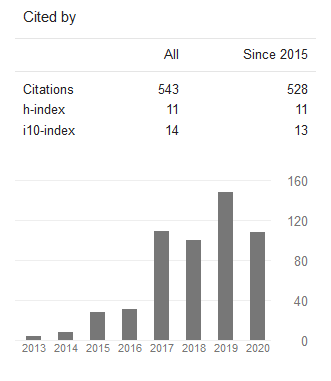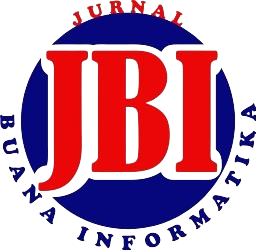Pengenalan Wajah Menggunakan Implementasi T-shape Mask pada Two Dimentional Linear Discriminant Analysis dan Support Vector Machine
DOI:
https://doi.org/10.24002/jbi.v7i1.478Abstract
Abstract. Face recognition is the identification process to recognize a person's face. Many studies have been developing face recognition methods, one of which is the Two Dimensional Linear Discriminant Analysis (TDLDA) which has pretty good accuracy results with the method of classification Support Vector Machine (SVM). With more training data can add computational time. TDLDA using all the piksel image as input to be processed for feature extraction. Though not all the objects in the area of the face is a significant feature in face recognition. In this study, the proposed use of the T-shape with only use a significant part is the eyes, nose, and mouth are integrated with TDLDA and SVM. The result could reduce computing time on face recognition 21.56% faster than TDLDA method. The accuracy of the results in this study was 91% -96% which is close to the level of accuracy without using a mask on the face.
Keyword: face recognition, T-shape, TDLDA, Support vector machine.
Abstrak. Pengenalan wajah merupakan proses identifikasi untuk mengenali wajah seseorang. Telah Banyak penelitian yang mengembangkan metode pengenalan wajah, salah satunya adalah Two Dimensional Linear Discriminant Analysis (TDLDA) yang memiliki hasil akurasi yang cukup baik dengan metode klasifikasi Support Vector Machine (SVM). Dengan semakin banyak data training dapat menambah waktu komputasinya. TDLDA menggunakan semua piksel citra sebagai masukan yang akan diproses untuk ekstrasi fitur. Padahal tidak semua objek pada area wajah merupakan fitur yang signifikan dalam pengenalan wajah. Dalam penelitian ini diusulkan penggunaan T-shape dengan hanya menyimpan bagian yang signifikan yaitu mata, hidung, dan mulut yang diintegrasikan dengan TDLDA dan SVM. Hasilnya dapat mengurangi waktu komputasi pada pengenalan wajah 21,56% lebih cepat daripada metode TDLDA. Hasil akurasi pada penelitian ini adalah 91%-96% yang mendekati tingkat akurasi tanpa menggunakan mask pada wajah.
Kata Kunci: pengenalan wajah, T-shape, TDLDA, Support vector machine.
References
. Belhumeur, P. N., & Hespanha, J. P., & Kriegman, D. J. 1997. Eigenfaces vs Fisherface: Recognition Using Class Specific Linear Projection. IEEE Transaction On Pattern Analysis And Machine Intelligence, 19, 711-720.
. Burges, C. J. C. 1998. A Toturial on Support Vector Machines for Pattern Recognition. Data Mining and Knowledge Discovery, 2(2), 955-974.
. Chung, B. W., Park, K. Y., & Hwang, S. Y. 2013. A Fast and Efficient Haar-Like Feature Selection Algorithm For Object Detection. The Journal of Korean Institute of Communications and Information Sciences, 38(6), 486-491.
. Damayanti, F., & Arifin, A. Z. 2010. Pengenalan Citra Wajah Menggunakan Metode Two-Dimensional Linear Discriminant Analysis dan Support Vector Machine. Jurnal Ilmiah Kursor, 5(3), 147-156.
. Gao, Q., & Zhang, L., & Zhang, D. 2008. Face Recognition Using FLDA with Single Training Image Per Person. ScienceDirect, 205(2), 726–734.
. Gu, X., & Liu, C., & Wang, S., & Zhao, C. 2015. Feature Extraction Using Adaptive Slow Feature Discriminant Analysis. ScienceDirect, 154, 139-148.
. Hsu, C. W. 2002. A Comparison of Methods for Multi-class Support Vector Machines. IEEE Transactions on Neural network, 13(2), 415-425.
. Koc, M. & Barkana, A. 2014. Discriminative Common Vector Approach Based Feature Selection In Face Recognition. ScienceDirect, 40(8), 37–50.
. Kong, H., & Wang, L., & Teoh, E. K., & Li, X., & Wang, J. G., & Venkateswarlu, R. 2005. Generalized 2D Principal Component Analysis For Face Image Representation and Recognition. ScienceDirect, 18(5), 585–594.
. Lenc, L., & Kral, P. 2015. Automatic Face Recognition System Based On The Sift Features. ScienceDirect.
. Li, M., & Yuan, B. 2005. 2D-LDA: A Statistical Linear Discriminant Analysis For Image Matrix. ScienceDirect, 26(5), 527–532.
. Ma, C., & Jung, J., & Kim, S., & Ko, S. 2015. Random Projection-Based Partial Feature Extraction For Robust Face Recognition. ScienceDirect, 149, 1232-1244.
. Sinha, P., & Balas, B. 2006. Face Recognition By Humans: Nineteen Results All Computer Vision Researchers Should Know About. Proc of the IEEE, 94(11), 1948-1962.
. Zhao, Y., & Liu, Y., & Zhong, S., & Hua, K. A. 2015. Face Recognition From A Single Registered Image For Conference Socializing. ScienceDirect, 42, 973-979.
. Zheng, W. S. 2008. 1D-LDA vs 2D-LDA: When is Vector-Based Linear Discriminant Analysis Better Than Matrix-Base. ScienceDirect, 2156-2172.
. Zhi, R., & Qiuqi, R. 2008. Two-dimensional Direct And Weighted Linear Discriminant Analysis For Face Recognition. ScienceDirect, 71, 3607-3611.
Downloads
Published
Issue
Section
License
Copyright of this journal is assigned to Jurnal Buana Informatika as the journal publisher by the knowledge of author, whilst the moral right of the publication belongs to author. Every printed and electronic publications are open access for educational purposes, research, and library. The editorial board is not responsible for copyright violation to the other than them aims mentioned before. The reproduction of any part of this journal (printed or online) will be allowed only with a written permission from Jurnal Buana Informatika.
This work is licensed under a Creative Commons Attribution-ShareAlike 4.0 International License.









